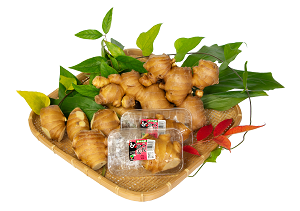Yatsushiro Shoga
| Registration Number | 95 |
|---|---|
| Name of the GI | Yatsushiro Shoga,Yatsushiro Ginger |
| Class | Vegetables/ Cereal grains/Pulses |
| Date of Protection | 2020/03/30 |
| Producing Area |
Kumamoto Prefecture
Yatsushiro City, Hikawa Town, Yatsushiro County, Kaito District, Ogawa Town, Uki City, and Misato Town central district, Shimomashiki County |
| Applicant - Name and Address | Yatsushiro Regional Agricultural Cooperative 1525-1 Nishikata-machi, Yatsushiro City, Kumamoto Prefecture |
Producing Area
Yatsushiro Shoga is a ginger produced by careful trimming (1) of enlarged rhizomes and shipped in accordance with strict standards.
This ginger features a colorful appearance with less unevenness and damage, and fresh and slightly spicy flavor.
Yatsushiro Shoga is highly appreciated in markets for its superior quality and stable shipment throughout the year, and it is traded at prices more than 30% higher than common ginger.
For the production of Yatsushiro Shoga, a superior line of the variety Oshoga is cultivated in the producing area, Yatsushiro region. A disease-free and superior rhizome collected in the region is used for seed ginger.
During cultivation, sparse planting is adopted considering rhizome enlargement and storability, depending on the cultivation environment such as the amount of sunlight.
After harvesting, it is stored in a storage location maintained in an appropriate temperature and humidity.
Shipping standards require harvested ginger to be rinsed with water, trimmed, and no damage caused by pests, injuries, or other factors.
The producing area of Yatsushiro Shoga has a valley-like topography surrounded by mountain forests with altitudes exceeding 500 to 1,000 meters.
Valley-shaped fields tend to lack sunlight. Thus, local farmers have established unique cultivation techniques, such as cultivating in consideration of enlarging rhizome and maintaining freshness to be able to store. In addition, by digging trenches in the tuff stratum, farmers are able to secure a storage location at a temperature and humidity suitable for ginger storage. This allows for the shipment of high-quality ginger around the year.
Ginger cultivation began in the region at the end of the Taisho period (2), and was introduced throughout the region in 1931.
With the aim of securing superior seed ginger, farmers have continued their efforts in farmland development and improvement in facilities and production techniques, thereby establishing a production area of high-quality ginger.
As of 2018, 111 farmers produce Yatsushiro Shoga, with an annual shipment of 605 tons.
- Trimming: The peeling process to remove uneven parts (sections, etc.) of ginger rhizomes is called trimming in the production stage.
- Taisho period: 1912 to 1926. A period in the history of Japan, and the shortest of all periods. Modernization continued as in the Meiji period, and democracy was advocated through the pro-Constitution movement and the establishment of a party cabinet.


